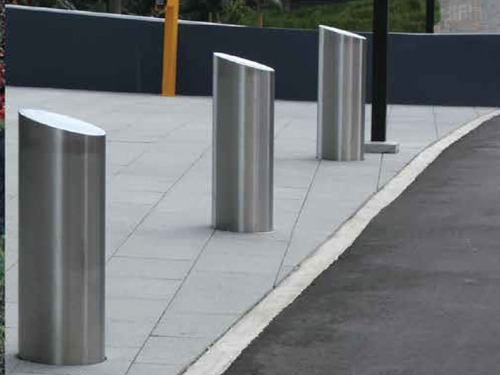With so many different types of bollards available, including steel bollards, it can be beneficial to understand the various types of bollards and the uses to which they are best suited. We’ve put up a helpful guide to assist you in determining the appropriate level of security for your institution.
Recognising the many types of bollards
The many varieties of bollards offer varying degrees of protection tailored to certain conditions. These are some examples:
Bollards for traffic
Traffic bollards separate traffic lanes, particularly during roadworks or other sorts of construction work. These bollards, which are very visible and typically temporary, can assist direct traffic to specified lanes.
Bollards for pedestrians
Pedestrian bollards limit zones that are strictly for foot traffic. You will find these bollards in situations where pedestrians are close to fast traffic lanes or other potential hazards.
Bollards for security
Security bollards work similarly to traffic bollards in that they separate traffic from people. They are, however, strengthened and frequently give a higher level of protection in the case of a vehicle collision.
‘Ram raid’ steel bollards are heavy-duty bollards
These heavy-duty bollards, similar to security bollards, are designed expressly to prevent vehicles from causing damage or obtaining access to very expensive or protected sites. These are often along footpaths in front of banks, jewellery stores, shopping centres, and other establishments.
Materials for bollards include iron, steel, concrete, and polymer.
Bollards are composed of various materials, some of which are more suited to specific tasks than others.
Steel bollards
Stainless steel bollards describe a range of stainless-steel uprights and metal posts. In addition to separating pathways and preventing car access, they frequently provide vehicle protection. They are weather-resistant, making them suitable for long-term outdoor usage.

Telescopic steel bollards
Telescopic bollards are temporary steel bollards that may be withdrawn or lowered to provide access, whilst others are permanent fixtures. Permanent steel bollards fasten to the ground or are concrete-secured.
Bollards made of concrete
Outdoors and concrete bollards are quite common. They are often in the shape of large concrete blocks. They offer strong protection from car impacts and are frequently in public areas with a high population of people as a kind of protection in the case of traffic accidents.
Standard bollards
This refers to bollards designed to withstand smaller-scale hits, such as those seen in car parks. Due to neighbouring cars’ speeds being likely to be slower, the force of contact on the bollard will be significantly lower. As a result, typical bollards should be able to withstand such an occurrence with just minor surface scratches or scuffs.
Heavy-duty bollards
As the name implies, these bollards are more common in regions where people anticipate vehicle hits to have more force due to higher speed or weight.
For example, materials handling vehicles such as forklift trucks and side-loaders in industrial environments like factories and warehouses would require heavy-duty bollards. These vehicles are larger than cars and carry significantly more weight. Even at lower speeds, they are more likely to do more significant harm in the case of an accident. Heavy-duty bollards offer a more robust degree of protection against such severe accidents.
We construct a broad range of steel structures, so if you’re looking for stainless steel protection, give us a call on 0800 612 7503 and speak to one of our experts about your needs today.
